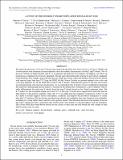A STUDY OF THE DIVERSE T DWARF POPULATION REVEALED BY WISE
Author(s)
Mace, Gregory N.; Davy Kirkpatrick, J.; Cushing, Michael C.; Gelino, Christopher R.; Griffith, Roger L.; Skrutskie, Michael F.; Marsh, Kenneth A.; Wright, Edward L.; Eisenhardt, P. R.; McLean, Ian S.; Thompson, Maggie A.; Mix, Katholeen; Bailey, Vanessa; Beichman, Charles A.; Bloom, Joshua S.; Burgasser, Adam J.; Fortney, Jonathan J.; Hinz, Philip M.; Knox, Russell P.; Lowrance, Patrick J.; Marley, Mark S.; Morley, Caroline V.; Rodigas, Timothy J.; Saumon, Didier; Sheppard, Scott S.; Stock, Nathan D.; ... Show more Show less
DownloadMace-2013-A STUDY OF THE DIVER.pdf (5.481Mb)
PUBLISHER_POLICY
Publisher Policy
Article is made available in accordance with the publisher's policy and may be subject to US copyright law. Please refer to the publisher's site for terms of use.
Terms of use
Metadata
Show full item recordAbstract
We report the discovery of 87 new T dwarfs uncovered with the Wide-field Infrared Survey Explorer (WISE) and 3 brown dwarfs with extremely red near-infrared colors that exhibit characteristics of both L and T dwarfs. Two of the new T dwarfs are likely binaries with L7 ± 1 primaries and mid-type T secondaries. In addition, our follow-up program has confirmed 10 previously identified T dwarfs and 4 photometrically selected L and T dwarf candidates in the literature. This sample, along with the previous WISE discoveries, triples the number of known brown dwarfs with spectral types later than T5. Using the WISE All-Sky Source Catalog we present updated color-color and color-type diagrams for all the WISE-discovered T and Y dwarfs. Near-infrared spectra of the new discoveries are presented along with spectral classifications. To accommodate later T dwarfs we have modified the integrated flux method of determining spectral indices to instead use the median flux. Furthermore, a newly defined J-narrow index differentiates the early-type Y dwarfs from late-type T dwarfs based on the J-band continuum slope. The K/J indices for this expanded sample show that 32% of late-type T dwarfs have suppressed K-band flux and are blue relative to the spectral standards, while only 11% are redder than the standards. Comparison of the Y/J and K/J index to models suggests diverse atmospheric conditions and supports the possible re-emergence of clouds after the L/T transition. We also discuss peculiar brown dwarfs and candidates that were found not to be substellar, including two young stellar objects and two active galactic nuclei. The substantial increase in the number of known late-type T dwarfs provides a population that will be used to test models of cold atmospheres and star formation. The coolest WISE-discovered brown dwarfs are the closest of their type and will remain the only sample of their kind for many years to come.
Date issued
2013-02Department
Massachusetts Institute of Technology. Department of PhysicsJournal
The Astrophysical Journal. Supplement Series
Publisher
IOP Publishing
Citation
Mace, Gregory N., J. Davy Kirkpatrick, Michael C. Cushing, Christopher R. Gelino, Roger L. Griffith, Michael F. Skrutskie, Kenneth A. Marsh, et al. “A STUDY OF THE DIVERSE T DWARF POPULATION REVEALED BY WISE.” The Astrophysical Journal Supplement Series 205, no. 1 (February 25, 2013): 6. © 2013 The American Astronomical Society
Version: Final published version
ISSN
0067-0049
1538-4365